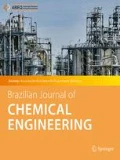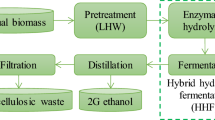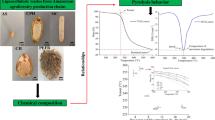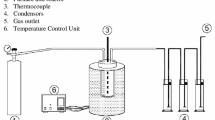Abstract
Pyrolysis of lignocellulosic biomass is a renewable way to obtain densified energy and increase the raw material value in three different products: biochar, bio-oil, and gas. Agricultural waste is a promising biomass due to its high availability, especially in tropical countries, and lack of destination besides combustion. The bioenergy and biorefining potential were evaluated for four agricultural wastes: corn stover (CS), bean pods (BP), sugarcane bagasse (SCB), and pineapple crowns leaves (PCL) through an extensive physical and chemical characterization by proximate, ultimate and compositional analysis, high heating value (HHV), ash chemical composition, thermogravimetric analysis and analytical pyrolysis through Py–GC/MS. The results show that the biomasses present high HHV (16.1–19.3 MJ kg−1), low moisture and ash content, and high volatile content (77.8–82.8%), which are great characteristics for bio-oil production. According to Py–GC/MS results, the main pyrolysis products were phenols, furans, and C1–C4 oxygenated compounds. CS and BP presented a high phenolics yield (26.5%), which could be potentially recovered through biorefining. PCL showed the greatest energetic potential due to its highest HHV and could generate a high-quality fuel after deoxygenation routes. The bio-oil of these biomasses is a potential source of value-added chemicals after biorefining routes.
Similar content being viewed by others
Data availability
Not applicable.
Code availability
Not applicable.
References
Astuti W, Sulistyaningsih T, Kusumastuti E, Yanny G, Sari R (2019) Bioresource technology thermal conversion of pineapple crown leaf waste to magnetized activated carbon for dye removal. Bioresour Technol 287:121426. https://doi.org/10.1016/j.biortech.2019.121426
Barbosa AS, Siqueira LAM, Medeiros RLBA, Melo DMA, Melo MAF, Freitas JCO, Braga RM (2019) Renewable aromatics through catalytic flash pyrolysis of pineapple crown leaves using HZSM-5 synthesized with RHA and diatomite. Waste Manag 88:347–355. https://doi.org/10.1016/j.wasman.2019.03.052
Biswas B, Pandey N, Bisht Y, Singh R, Kumar J, Bhaskar T (2017) Bioresource technology pyrolysis of agricultural biomass residues: comparative study of corn cob, wheat straw, rice straw and rice husk. Bioresour. Technol. https://doi.org/https://doi.org/10.1016/j.biortech.2017.02.046
Borel LDMS, de Lira TS, Ataíde CH, de Souza Barrozo MA (2020) Thermochemical conversion of coconut waste: material characterization and identification of pyrolysis products. J Therm Anal Calorim. https://doi.org/10.1007/s10973-020-09281-y
Braga RM, Queiroga TS, Calixto GQ, Almeida HN, Melo DMA, Melo MAF, Freitas JCO, Curbelo FDS (2015) The energetic characterization of pineapple crown leaves. Environ. Sci. Pollut. Res. 22. https://doi.org/https://doi.org/10.1007/s11356-015-5082-6
Instituto Brasileiro de Geografia e Estatística – IBGE. Levantamento sistemático da produção agrícola. 2020. In portuguese.
Caceres NT, Alcarde JC (1995) Adubação verde com leguminosas em rotação com cana-de-açúcar (Saccharum spp.). Revista STAB 13:16–19 (In Portuguese)
Chen X, Che Q, Li S, Liu Z, Yang H, Chen Y, Wang X, Shao J, Chen H (2019a) Recent developments in lignocellulosic biomass catalytic fast pyrolysis: Strategies for the optimization of bio-oil quality and yield. Fuel Process Technol 196:106180. https://doi.org/10.1016/j.fuproc.2019.106180
Chen X, Li S, Liu Z, Chen Y, Yang H, Wang X, Che Q, Chen W, Chen H (2019b) Bioresource Technology Pyrolysis characteristics of lignocellulosic biomass components in the presence of CaO. Bioresour Technol 287:121493. https://doi.org/10.1016/j.biortech.2019.121493
Chen Y, Fang Y, Yang H, Xin S, Zhang X, Wang X, Chen H (2019c) Effect of volatiles interaction during pyrolysis of cellulose, hemicellulose, and lignin at different temperatures. Fuel 248:1–7. https://doi.org/10.1016/j.fuel.2019.03.070
Dhyani V, Bhaskar T (2019) Pyrolysis of biomass. Biomass, Biofuels, Biochem. Biofuels Altern. Feed. Convers. Process. Prod. Liq. Gaseous Biofuels 217–244. https://doi.org/https://doi.org/10.1016/B978-0-12-816856-1.00009-9
Hawash SI, Farah JY, El-Diwani G (2017) Pyrolysis of agricultural wastes for bio-oil and char production. J Anal Appl Pyrol 124:369–372
Hu X, Gholizadeh M (2019) Biomass pyrolysis: A review of the process development and challenges from initial researches up to the commercialisation stage. J Energy Chem 39:109–143. https://doi.org/10.1016/j.jechem.2019.01.024
Isikgor FH, Becer CR (2015) Lignocellulosic biomass: a sustainable platform for production of bio-based chemicals and polymers. Polym Chem 6:4497–4559
Karlen DL, Sadler EJ, Camp CR (1987) Dry matter, nitrogen, phosphorus, and potassium accumulation rates by corn on norfolk loamy sand (AJ) 656.
Kojima Y, Akazawa M, Kato Y (2015) Formation of polycyclic compounds from phenols by fast pyrolysis. EC Agriculture 1:67–85
Lima VP, Reinhardt DH, Costa JA (2001) Desbaste de mudas do tipo filhote do abacaxi cv. Pérola: 1. Produção e qualidade do fruto. Rev Bras Frutic 23:634–638 (In Portuguese)
Liu Z, Wang L, Li Y, Li Z (2016). Study on Phenolic Content in Fast Pyrolysis Oil Obtained from the Model compounds of Three Major Components in Biomass. https://doi.org/10.2991/aeecs-16.2016.46
Mishra RK, Mohanty K (2020) Kinetic analysis and pyrolysis behaviour of waste biomass towards its bioenergy potential. Bioresour Technol 311:123480. https://doi.org/10.1016/j.biortech.2020.123480
Morais LC, Maia AAD, Guandique MEG, Rosa AH (2017) Pyrolysis and combustion of sugarcane bagasse. J Therm Anal Calorim 129:1813–1822. https://doi.org/10.1007/s10973-017-6329-x
Nunes LJR, Matias JCO, Catalão JPS (2016) Biomass combustion systems: a review on the physical and chemical properties of the ashes. Renew Sustain Energy Rev 53:235–242. https://doi.org/10.1016/j.rser.2015.08.053
Romero E, Quirantes M, Nogales R (2017) Characterization of biomass ashes produced at different temperatures from olive-oil-industry and greenhouse vegetable wastes. Fuel 208:1–9. https://doi.org/10.1016/j.fuel.2017.06.133
Rosolem CA (1994) Nutrição e Adubação do Feijoeiro. Piracicaba: Associação Brasileira para Pesquisa da Potassa e do Fosfato. In Portuguese
Shah MA, Khan MNS, Kumar V (2018) Biomass residue characterization for their potential application as biofuels. J Therm Anal Calorim 134:2137–2145. https://doi.org/10.1007/s10973-018-7560-9
Sharifzadeh M, Sadeqzadeh M, Guo M, Borhani TN, Murthy NVSN, Cortada M, Wang L, Hallett J, Shah N, Berkeley L, Bioenergy J (2019) The multi-scale challenges of biomass fast pyrolysis and bio-oil upgrading: review of the state of art and future research directions. Prog Energy Combust Sci 71:1–80. https://doi.org/10.1016/j.pecs.2018.10.006
Silva JE, Calixto GQ, de Almeida CC, Melo DMA, Melo MAF, Freitas JCO, Braga RM (2019) Energy potential and thermogravimetric study of pyrolysis kinetics of biomass wastes. J Therm Anal Calorim 137. https://doi.org/https://doi.org/10.1007/s10973-019-08048-4
Singh RK, Pandey D, Patil T, Sawarkar AN (2020) Pyrolysis of banana leaves biomass: physico-chemical characterization, thermal decomposition behavior, kinetic and thermodynamic analyses. Bioresour Technol 310:123464. https://doi.org/10.1016/j.biortech.2020.123464
Trninc M, Jovovic A, Stojiljkovic D (2016) A steady state model of agricultural waste pyrolysis: a mini review. Waste Manage Res 34:851–865
Wu D, Xiao L, Ba Y, Wang H, Zhang A, Wu X, Niu M, Fang K (2017) The recovery of energy, nitrogen and phosphorous from three agricultural wastes by pyrolysis. Energy Procedia 105:1263–1269. https://doi.org/10.1016/j.egypro.2017.03.445
Yang H, Yan R, Chen H, Lee DH, Zheng C (2007) Characteristics of hemicellulose, cellulose and lignin pyrolysis. Fuel 86:1781–1788. https://doi.org/10.1016/j.fuel.2006.12.013
Yildiz G, Ronsse F, Venderbosch R, van Duren R, Kersten SRA, Prins W (2015) Effect of biomass ash in catalytic fast pyrolysis of pine wood. Appl Catal B Environ 168–169:203–211. https://doi.org/10.1016/j.apcatb.2014.12.044
Yong J, Kim J, Oh C, Park J, Kwon EE (2019) Production of bio-oil from fast pyrolysis of biomass using a pilot-scale circulating fl uidized bed reactor and its characterization. J Environ Manage 234:138–144. https://doi.org/10.1016/j.jenvman.2018.12.104
Acknowledgements
The authors appreciate the financial support from CNPq/Brazil and Capes/Brazil (process 88882.375742/2019-1) for this research. We would also like to thank LABTAM/UFRN, LNA/UFRN, and Escola Agrícola de Jundiaí/UFRN for the infrastructure provided.
Funding
This work was supported by Conselho Nacional de Desenvolvimento Científico e Tecnológico (CNPq)/Brazil and Coordenação de Aperfeiçoamento de Pessoal de Nível Superior (CAPES)/Brazil (process 88882.375742/2019–1). We would also like to thank LABTAM/UFRN, LNA/UFRN, Petrobras and Escola Agrícola de Jundiaí/UFRN for the facilities.
Author information
Authors and Affiliations
Contributions
All authors contributed to the study conception and design. Material preparation, data collection and analysis were performed by Guilherme Quintela Calixto and Renata Martins Braga. The first draft of the manuscript was written by Guilherme Quintela Calixto and all authors commented on previous versions of the manuscript. All authors read and approved the final manuscript.
Corresponding author
Ethics declarations
Conflict of interest
The authors declare that they have no conflict of interest.
Rights and permissions
About this article
Cite this article
Calixto, G.Q., Melo, D.M.A., Melo, M.A.F. et al. Analytical pyrolysis (Py–GC/MS) of corn stover, bean pod, sugarcane bagasse, and pineapple crown leaves for biorefining. Braz. J. Chem. Eng. 39, 137–146 (2022). https://doi.org/10.1007/s43153-021-00099-1
Received:
Revised:
Accepted:
Published:
Issue Date:
DOI: https://doi.org/10.1007/s43153-021-00099-1










